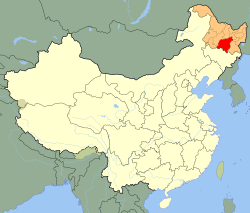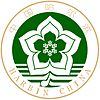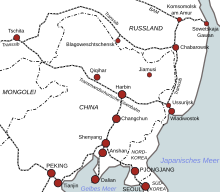Harbin
| Hā'ěrbīn Shì 哈尔滨 市 Harbin |
|||
|---|---|---|---|
 Cityscapes |
|||
|
|||
| Coordinates | 45 ° 45 ' N , 126 ° 38' E | ||
 |
|||
| Basic data | |||
| Country | People's Republic of China | ||
| region | Northeast China | ||
| province | Heilongjiang | ||
| ISO 3166-2 | CN-HL | ||
| status | Sub-provincial town | ||
| structure | 9 city districts, 2 independent cities, 7 districts | ||
| height | 150 m | ||
| surface | 2089 km² | ||
| Metropolitan area | 4275 km² | ||
| Residents | 4,517,549 (2010) | ||
| Metropolitan area | 5,282,083 (2010) | ||
| density | 2,162.5 Ew. / km² | ||
| Metropolitan area | 1,235.6 Ew. / km² | ||
| Post Code | 150000 | ||
| Telephone code | (+86) 451 | ||
| Time zone | China Standard Time (CST) UTC +8 |
||
| License Plate | 黑 A | ||
| Website | www.harbin.gov.cn | ||
| politics | |||
| mayor | Zhang Xiaolian (张 效 廉) | ||
Harbin ( Chinese 哈爾濱 市 / 哈尔滨 市 , Pinyin Hā'ěrbīn Shì , W.-G. Ha-erh-pin ; Manchurian ᡥᠠᠯᠪᡳᠨ; russian Харби́н / Charbin ) is the capital of the province of Heilongjiang ( Amur province ), Manchuria , China , on the River Songhua River with a population of 4,596,313 in the urban area (census 2010). There are 4.8 million people in the urban agglomeration and 10.98 million people lived in the total area in 2016.
Administrative division and population
Administrative division of Harbins
The sub-provincial city of Harbin is made up of nine municipalities , two independent cities and seven districts at the county level . These are:
Population development of the agglomeration
According to the UN, almost 6 million people lived in the actual urban agglomeration of the city (as of 2017). The rest of the population lives in the rural area. Due to advancing urbanization, 7.9 million inhabitants are expected in the agglomeration by 2035.
| year | population |
|---|---|
| 1950 | 726,000 |
| 1960 | 1,423,000 |
| 1970 | 1,696,000 |
| 1980 | 1,992,000 |
| 1990 | 2,515,000 |
| 2000 | 4,100,000 |
| 2010 | 5,140,000 |
| 2017 | 5,984,000 |
Ethnic composition of the total population of Harbin (2000)
The 2000 census counted 9,413,359 inhabitants for the entire administrative area of Harbins.
| Name of the people | Number d. Residents | Share in percent |
|---|---|---|
| Han | 8,796,610 | 93.45 |
| Manchu | 433,340 | 4.6 |
| Korean | 119,883 | 1.27 |
| Hui | 39,995 | 0.43 |
| Mongols | 13.163 | 0.14 |
| Xibe | 4,741 | 0.05 |
| Daur | 938 | 0.01 |
| Others | 4,689 | 0.05 |
history
The city was founded by Russians in 1898 - after the occupation of northern Manchuria by Russia - as a train station of the Transmanchurian Railway , which is why the cityscape of the older parts of the city is still characterized by Russian architecture. After the October Revolution in particular , many Russians fled to Harbin and contributed to the prosperity of the city. In 1932 the city was occupied by Japanese troops. After Japan surrendered in World War II , the Soviet Union took over the city. Although they handed the city over to the Republic of China as agreed , the Red Army troops remained stationed there. With her tacit approval, the Chinese Communist Party was able to conquer the city as early as 1946. The industrial facilities there served them as the basis for victory in the civil war .
After the founding of the People's Republic of China , the heavy industry in Harbin was expanded. To this end, people from southern China were resettled here and the Technical University was reinforced by teachers from the south. Many of these people returned to their old homeland after the easing of the housing regulations.
Since the economic reform, Harbin and Heilongjiang Province have been trying to establish themselves as bridgeheads in trade with Russia .
In November 2005, the Jilin chemical accident contaminated the water of Songhua Jiang with benzene , causing the city's drinking water supply to be cut for several days.
Heavy smog spread over Harbin on October 20, 2013 . The airport, schools and kindergartens were closed for three days. All highways were closed after series of accidents. The city's coal-fired heating system was started in relatively warm weather with little wind. On October 25th, cold air flowing in from Siberia caused the smog to rise and subside.
geography
The urban area extends mainly on the south bank of the Songhua Jiang , a tributary of the Heilong Jiang (Amur). The north bank is being developed as a local recreation area. The urban area is largely flat, there are only differences in level of around 150 meters. The area covers 56,579 km², of which 7086 km² urban area.
Harbin lies between 125 ° 42'-130 ° 10 'East and 44 ° 04'-46 ° 40' North.
climate
The winters are very cold in Harbin, at night the temperature can drop to -40 ° C. Often it starts to snow in October and the frost usually ends at the end of April. Accordingly, the growing season is relatively short. In summer the city is pleasantly cool by Chinese standards, so that it is a popular conference location in China in summer.
| Harbin | ||||||||||||||||||||||||||||||||||||||||||||||||
|---|---|---|---|---|---|---|---|---|---|---|---|---|---|---|---|---|---|---|---|---|---|---|---|---|---|---|---|---|---|---|---|---|---|---|---|---|---|---|---|---|---|---|---|---|---|---|---|---|
| Climate diagram | ||||||||||||||||||||||||||||||||||||||||||||||||
| ||||||||||||||||||||||||||||||||||||||||||||||||
|
Monthly average temperatures and rainfall for Harbin
|
|||||||||||||||||||||||||||||||||||||||||||||||||||||||||||||||||||||||||||||||||||||||||||||||||||||||||
economy
According to a study from 2014, Harbin had a gross domestic product of 127.9 billion US dollars in purchasing power parity . In the ranking of the economically strongest metropolitan regions worldwide, the city took 104th place. The GDP per capita is $ 12,865 (PPP). At 10.1% in the period from 2009 to 2014, GDP per capita grew rapidly.
Branches of production
Harbin is an industrial location with branches such as mechanical engineering , light industry , textile industry , medicine , food industry , automotive industry , electronics , chemical industry . The production play a dominant role of power plant equipment, aircraft, buses, measuring instruments as well as the production of larger quantities of aluminum - magnesium - alloys for further processing in other Chinese plants or for export. The Harbin City Commercial Bank is in the area of granting small loans very active.
Trading center
The Harbin Fair takes place annually from June 15 to 21. It is the most important universal fair in Northeast Asia and was first held in 2001.
education
There are 19 universities in Harbin with around 70,000 students, of which the Harbin Institute of Technology is one of the top ten in China. There are also 22 adult universities with around 116,000 students.
traffic
Flight connections
Harbin Taiping ( IATA : HRB, ICAO : ZYHB) is the largest international airport in northern China, with direct flights to the USA, Russia, Japan and Korea.
railroad
Harbin is also an important railway junction in northeast China. Five railway lines connect the city with Beijing (Jingha Line), Suifenhe (Binsui Line), Manzhouli (Binzhou Line), Beian (Binbei Line) and Lalin (Labin Line). In addition, a high-speed railway line runs between Harbin and Dalian , and another was opened at the end of 2018: the Harbin – Mudanjiang railway line . The city has the following train stations:
- Hauptbahnhof (opened in 1899 and expanded in 1999)
- Harbin East Station (opened in 1934)
- Harbin West Railway Station (completed in 2012)
- Harbin North Railway Station (since 2014)
Port, waterways and bridges
The first and also the only inland port in China is located in the Harbin area and is a developed natural port. It is of medium size, has a connection to the railway network and is also used for the shipping of export goods.
Harbin is connected to the system of about 1,900 rivers in Heilongjiang Province via the Songhua River. This enables extensive passenger and cargo shipping. The Harbin Yangmingtan Bridge suspension bridge , which was opened to traffic in 2011, (probably) collapsed under the load of several heavy vehicles in the summer of 2012, killing three people.
The Harbin Songpu Bridge , a modern cable-stayed bridge , also spans the river . It was opened to traffic in October 2010, is around 4 kilometers long, has two lanes in each direction, and cost 1.6 billion yuan to build .
Road system
Five express highways and five motorways run through the city or along the tangent . This well-developed road system together with the city streets provides the residents with everything they need.
Inner-city traffic
In 2009, the construction of a subway system ( Metro Harbin ) began, which should have nine lines and a ring line when completed (around 2027). The first line opened in 2013 and forms an east-west connection between the Medical University and the Ostbahnhof. It is around 18 km long and consists of 18 stations.
tourism
Ice and snow festivals
In winter, usually from early January to mid-February, Harbin hosts the Ice and Snow Festival and the Ice Lantern Festival. Ice and snow sculptures, some of which are filigree, are then exhibited at various locations in the city . The largest sculptures are replicas of famous monuments such as the Louvre in Paris or the Beijing Summer Palace. The sculptures can be several meters high and are illuminated in multiple colors from the inside at night. In January 2009 there were also four lanes of ice slides that were made entirely of ice, not just to look at, but also to use. The festival was first held in 1984 and has now developed into a winter tourist attraction. It is one of the four largest ice and snow festivals in the world (next to the Sapporo Snow Festival, the Ski Festival in Oslo and the Winter Solstice Celebration in Québec ).
The venues include the Harbin Engineering University site, Zhaolin Park, and Sun Island Landscape Area (this is where the snow sculptures are primarily made). In 2012, a new official world record was set: 52 teams from all over the world used 1,858 cubic meters of snow for their sculptures. The first prize at the International Collegiate Snow Sculpture Contest 2012 was won by a team of students from the University of Milwaukee in the USA .
Brewery
Since 2002 an international beer festival (based on the Munich Oktoberfest ) has been held every year in July . The city can look back on the longest tradition of beer brewing in China: The Harbiner Brewery was founded in 1900, three years before the world-famous Tsingtao Brewery .
music
The Harbin Symphony Orchestra, founded in 1908, is China's oldest orchestra . The Harbin Music School No. 1 was founded in 1928 by immigrants to Harbin who arrived here when the main train station opened, mostly Russians. Around 100 world-famous musicians have emerged from this first music school in China. The Harbin Summer Music Concert includes a whole series of concerts and is well attended. It started in 1958 (officially 1961) and was organized annually until the Cultural Revolution in 1966. A resumption took place in 1974, initially still annually in August. Since 1994 it has been held every two years in various locations in the city.
The UNESCO took Harbin in 2010 as a member of the Creative Cities Network as Music City on.
The Harbin Grand Theater opened in 2015 .
Tiger farm
About 800 Siberian tigers live in a tiger farm in Harbin in order to take the pressure off the wild tigers and to enable the resettlement of tigers in former tiger areas (Kazakhstan, East China).
Town twinning
-
 Magdeburg (Germany), since 2008
Magdeburg (Germany), since 2008 -
 Minneapolis (USA), since 1992
Minneapolis (USA), since 1992 -
 Krasnodar (Russia)
Krasnodar (Russia) -
 Wiener Neustadt (Austria)
Wiener Neustadt (Austria) -
 Vitebsk (Belarus)
Vitebsk (Belarus) -
 Edmonton (Canada)
Edmonton (Canada) -
 Aarhus (Denmark)
Aarhus (Denmark) -
 Murmansk (Russia), since 2015
Murmansk (Russia), since 2015 -
 Cascais (Portugal, in preparation since 2015)
Cascais (Portugal, in preparation since 2015)
architecture

Different types of buildings, classical and modern Chinese as well as Japanese and European buildings can be seen here. The dragon tower, completed in 2000, is one of the highest steel lattice towers in the world. According to the ethnic composition of the inhabitants, the city area also has a wide variety of religious buildings.
Rocket launch site
The Chinese military operates a launch site near Harbin for testing military missiles.
sons and daughters of the town
- Pierre Batcheff (1901–1932), French actor
- Nikolai Tscheboksarow (1907–1980), Soviet ethnographer and anthropologist
- Louis Klemantaski (1907-2001), British photographer and racing car driver
- Nikos Kavvadias (1910–1975), Greek writer
- Xiao Hong (1911–1942), Chinese writer (born in what is now the city district and then still an independent Hulan )
- Efraim Reuytenberg (1914–2005), Israeli painter
- Rudolph Pariser (* 1923), American chemist
- Lidija Wertinskaja (1923–2013), Soviet painter and actress
- Benjamin Lees (1924-2010), American composer
- Julie Ann Jardine (1926–2012), science fiction writer
- Inessa Koslowskaja (1927–2020), Russian neurophysiologist and aerospace specialist
- Semjon Gerschtein (* 1929), Russian theoretical physicist
- Li Ao (1935–2018), Chinese writer, historian and politician
- Robert Skidelsky (* 1939), British economic historian
- Yao Bin (* 1957), Chinese figure skater and figure skating coach
- Yang Yi (* 1964), writer (Japanese)
- Li Bingbing (* 1973), Chinese actress and singer
- Zhao Hongbo (* 1973), Chinese figure skater
- Kong Linghui (* 1975), Chinese table tennis world champion
- Yang Yang (* 1976), Chinese short track speed skater
- Shen Xue (* 1978), Chinese figure skater
- Pang Qing (* 1979), Chinese figure skater
- Tong Jian (* 1979), Chinese figure skater
- Guo Zhengxin (* 1979), Chinese figure skater
- Liu Yin (* 1981), Chinese curler
- Wang Fei (* 1982), Chinese speed skater
- Wang Fengchun (* 1982), Chinese curler
- Liu Rui (* 1982), Chinese curler
- Zhou Yan (* 1982), Chinese curler
- Wanting Qu (born 1983), Chinese singer
- Wang Bingyu (* 1984), Chinese curler
- Zhang Hao (* 1984), Chinese figure skater
- Li Hongxue (* 1984), Chinese cross-country skier
- Xu Xiaoming (* 1984), Chinese curler
- Wang Beixing (* 1985) Chinese speed skater
- Zhang Dan (* 1985), Chinese figure skater
- Yu Jing (* 1985), Chinese speed skater
- Yue Qingshuang (* 1985), Chinese curler
- Zhang Jilin (* 1986), Chinese chess player
- Ji Cheng (* 1987), Chinese racing cyclist
- Xu Wenlong (* 1987), Chinese cross-country skier
- Sun Qinghai (* 1988), Chinese cross-country skier
- Zang Jialiang (* 1988), Chinese curler
- Wang Hao (* 1989), Chinese chess player
- Man Dandan (* 1989), Chinese cross-country skier
- Simu Liu (* 1989), Chinese-Canadian actor
- Yu Wenxia (* 1989), Chinese beauty queen and a model
- Han Cong (* 1992), Chinese figure skater
- Li Xin (* 1992), Chinese cross-country skier
- Cai Xuetong (* 1993), Chinese snowboarder
- Sui Wenjing (* 1995), Chinese figure skater
- Yan Han (* 1996), Chinese figure skater
literature
- Izabella Goikhman: Harbin. In: Dan Diner (Ed.): Encyclopedia of Jewish History and Culture (EJGK). Volume 2: Co-Ha. Metzler, Stuttgart / Weimar 2012, ISBN 978-3-476-02502-9 , pp. 539-544 (Jewish history in Harbin).
Web links
- Official site of the Harbin City (English)
- Info page (chinese)
- Travel impressions (English)
Individual evidence
- ↑ Heilongjiang (China): Prefecture Level, Cities & Counties - Population Statistics, Maps, Graphics, Weather and Web Information. Retrieved February 5, 2018 .
- ↑ World Urbanization Prospects - Population Division - United Nations. Retrieved July 23, 2018 .
- ↑ Ukraine: Secret service publishes Stalin files , accessed August 1, 2014
- ↑ see also English Wikipedia
- ^ Alan Berube, Jesus Leal Trujillo, Tao Ran, and Joseph Parilla: Global Metro Monitor . In: Brookings . January 22, 2015 ( brookings.edu [accessed July 30, 2018]).
- ↑ Harbin Port on worldportsource.com
- ↑ Harbin Bridge Collapse: Poor Construction or Overloaded Trucks?
- ↑ Harbin Songpu Bridge is officially open to traffic. on Xinghua, accessed March 13, 2015.
- ^ Projects Harbin Metro , accessed March 13, 2015.
- ↑ Test slide in the ice city . In: Berliner Zeitung , 27./28. December 2008, p. 10.
- ↑ Showarticle ( Memento from March 25, 2012 in the Internet Archive )
- ^ UWM team wins Chinese Snow Sculpture Competition ( Memento from February 2, 2015 in the Internet Archive ); accessed on May 26, 2019.
- ^ Harbin International Beer Festival ; accessed on March 13, 2015.
- ^ Chinese Famous Contemporary Musicians and the Historical Achievements of the Jewish Musicians in Harbin
- ^ Harbin Summer Music Concert , accessed March 13, 2015.
- ↑ UN recognizes China's northeastern Harbin as "Music City" on Xinhua, ( Peoples Daily online ). Retrieved March 13, 2015.
- ^ Harbin Opera House / MAD Architects. December 16, 2015. Accessed March 30, 2019 (American English).
- ↑ Мурманск и Харбин стали побратимами
- ↑ Cascais e Harbin (China) querem ser irmãs - “Cascais and Harbin (China) want to become sisters” , article from April 16, 2015 on the website of the city of Cascais, accessed on January 5, 2018
- ↑ Harbin in the Encyclopedia Astronautica , accessed October 18, 2011 (English).






